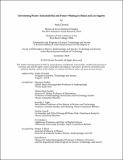Envisioning Water: Sustainability and Future-Making in Dubai and Los Angeles
Author(s)
Christidi, Nadia
DownloadThesis PDF (11.12Mb)
Advisor
Walley, Christine
Terms of use
Metadata
Show full item recordAbstract
The following dissertation explores how the future of water is being imagined, planned and
prepared for in two dryland cities – hyper-arid Dubai and semi-arid Los Angeles – as the
climate changes and as they face increasing pressures to become more ‘sustainable.’ Both
Dubai and LA are cities that have long been deemed unsustainable, but are aiming to
become sustainability leaders. Dubai, which relies on energy-intensive desalination and has
high water consumption, including in ubiquitous urban greening, is investing heavily in
achieving efficiencies and powering water through clean energy. Los Angeles, which
sources the majority of its water through aqueduct systems from faraway places where
water is becoming increasingly taxed, is looking to produce more of its water supply
locally, and especially through wastewater recycling. Throughout the dissertation, I trace
the plans, projects, and policies being introduced in this vein to consider how
‘sustainability’ initiatives play out and get negotiated through the socio-political and
political economic structures in the two cities to unique effects.
To get at sustainability’s variegated forms and effects, I first view sustainability as a
“boundary object” (Star and Griesemer) and “technology of imagination” (Pederson et. al).
Treating sustainability as a “boundary object” that is shared but viewed differently by
actors enables me to hone in on the interests and forces - sometimes countervailing - that
shape sustainability projects. Treating it as a technology of imagination allows me to get at
the imaginative effects that sustainability projects constitute. Second, I consider how these
interests, forces, and effects emerge from and get mediated through entrenched structures
like bureaucratic systems, accumulation regimes, and sunken investments, which produce
a stickiness to infrastructures and infrastructural visions that renders change challenging,
slow, and incremental. As such, I show, for instance, how Dubai’s highly centralized
governance structure and foreign-investment development model produce an emphasis on
sustainability’s enhancement of the city-state’s competitiveness agenda that can belie
larger eco-realities, while LA’s fragmented institutional, regulatory, and financing scapes
complicate collaboration on recycling projects which span across and exceed individual
institutional mandates.
Finally, alongside the municipal projects I focus on, I also look at visions of the future by
artists, designers, and architects to get at how the arts might provide alternatives that in some cases could help get beyond the stickiness of sustainability as it is currently being
imagined.
Date issued
2024-09Department
Massachusetts Institute of Technology. Program in Science, Technology and SocietyPublisher
Massachusetts Institute of Technology